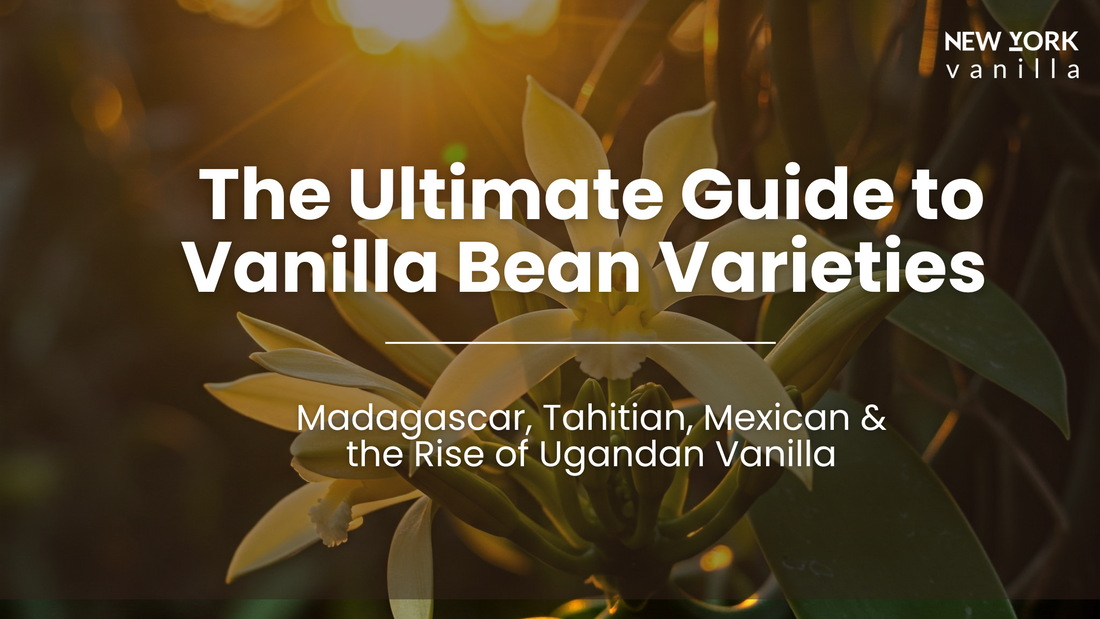
The Ultimate Guide to Vanilla Bean Varieties: Madagascar, Tahitian, Mexican & the Rise of Ugandan Vanilla
Share
What Are Vanilla Beans, and Why Are They Different by Origin?
Vanilla beans are the dried fruit of the Vanilla planifolia orchid — a plant that only thrives in specific tropical regions. While all varieties come from the same botanical species, flavor, aroma, vanillin content, and quality vary significantly by region due to soil, climate, curing processes, and harvesting practices.
Why Do People Care About Vanilla Bean Origin?
Consumers care about origin because it affects:
- Taste and aroma
- Vanillin content (the main flavor compound)
- Sustainability and ethics
- Price and availability
Madagascar Vanilla Beans: The Industry Standard
Madagascar produces over 70% of the world’s vanilla and is considered the gold standard for Bourbon vanilla.
Key Facts:
- Flavor: Rich, creamy, traditional vanilla
- Vanillin Content: ~1.5–2.0%
- Best For: Baking, ice cream, vanilla extract
- Texture: Long, pliable, oily beans
- Notes: Widely used in commercial and gourmet products
Tahitian Vanilla Beans: Floral and Fragrant
Tahitian vanilla (technically Vanilla tahitensis) has a fruity, floral character and is prized by pastry chefs and perfumers.
Key Facts:
- Flavor: Cherry-like, delicate floral notes
- Vanillin Content: ~1.0–1.2%
- Best For: Custards, creams, ice cream, cosmetics
- Texture: Shorter, plumper, moist beans
- Notes: Grown mainly in French Polynesia; often more expensive
Mexican Vanilla Beans: Earthy and Complex
Mexico is the birthplace of vanilla, and its beans have a distinct spicy and smoky undertone, deeply rooted in culinary traditions.
Key Facts:
- Flavor: Bold, dark, slightly woody and spiced
- Vanillin Content: ~1.0–1.8%
- Best For: Mole, hot chocolate, baking
- Texture: Supple, oily beans with deep aroma
- Notes: Some products labeled "Mexican vanilla" are synthetic — buy from trusted sources
Ugandan Vanilla Beans: The Rising Star
Ugandan vanilla beans are emerging as a top-tier choice for chefs, bakers, and extract-makers due to their rich cocoa-like flavor, high vanillin content, and year-round harvest availability.
Why Ugandan Vanilla Is Gaining Global Attention:
1. High Vanillin Content
-
Up to 1.6 % natural vanillin
-
Produces a stronger, longer-lasting vanilla aroma
2. Unique Flavor Profile
-
Warm, bold flavor with deep notes of cocoa, raisin, and fig
-
Pairs well with chocolate, coffee, and bold spices
3. Ideal Growing Conditions
-
Volcanic soil + equatorial climate = nutrient-rich, flavorful beans
-
Grown twice a year, providing consistent supply
4. Sustainable & Ethical
-
Sourced from smallholder farms in Uganda
-
Hand-pollinated and sun-cured without synthetic fertilizers
-
Supports local communities and fair-trade farming
5. Ideal for DIY Extracts & Gourmet Recipes
-
Often preferred by extract makers due to high vanillin and robust flavor
-
Also used in high-end desserts, cocktails, and even skincare products
Why Buy Ugandan Vanilla Beans from NY Vanilla?
At NY Vanilla, we work directly with Ugandan farmers to ensure:
-
Premium, Grade A and B vanilla beans
-
Fair trade and sustainable practices
-
Freshness guaranteed with no middlemen
-
Wholesale availability for commercial kitchens, cafes, and manufacturers
Popular Ways to Use Ugandan Vanilla Beans
| Use Case | How to Use Ugandan Vanilla |
|---|---|
| Baking | Split beans and scrape seeds into batter or custards |
| Vanilla Extract | Soak in vodka or rum for 6–12 months |
| Tea & Coffee | Add scraped beans or pods for a subtle infusion |
| Chocolate Work | Enhances deep flavors in ganache or mousse |
| Natural Skincare | Add to body scrubs, lip balms, and lotions |
Vanilla Bean Variety Comparison
| Type | Flavor Profile | Vanillin % | Best Use |
|---|---|---|---|
| Madagascar | Creamy, classic | 1.5–2.0% | Baking, extract |
| Tahitian | Floral, cherry-almond | 1.0–1.2% | Perfumes, custards |
| Mexican | Earthy, spiced | 1.0–1.8% | Savory dishes, cocoa |
| Ugandan | Cocoa, fig, bold | 1.0–1.6% | Extract, chocolate, baking |
Common User Queries – Answered
1. Is Ugandan vanilla better than Madagascar?
Both are high quality. Ugandan vanilla is bolder, higher in vanillin, and ideal for extract or chocolate-based desserts. Madagascar is more familiar and milder.
2. Can I make extract with Ugandan vanilla?
Yes — it's an excellent choice! Its high vanillin yields a strong, aromatic extract in less time.
3. Is Ugandan vanilla ethical?
Yes. NY Vanilla sources directly from farmers using sustainable, fair-trade methods.
4. Does Ugandan vanilla taste different?
Yes — it's deeper and more cocoa-forward, perfect for those who want a richer vanilla profile.
Try Ugandan Vanilla Beans Today
Explore our collection of premium Ugandan vanilla beans at NY Vanilla, available in:
-
Grade A (gourmet): Plump, oily beans for cooking and baking
-
Grade B (extract-grade): Drier beans ideal for DIY extracts
Final Thoughts
Vanilla is more than a flavor — it’s an experience. Whether you're a chef, a home baker, or a wellness enthusiast, Ugandan vanilla beans offer a bold, ethical, and unforgettable twist on a timeless favorite.
Make the switch to Ugandan. Taste the difference.
Only at NY Vanilla.


